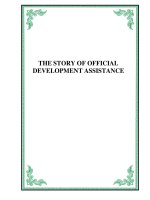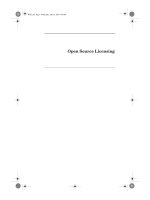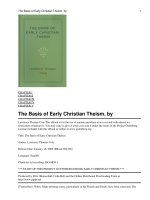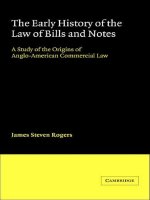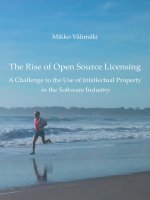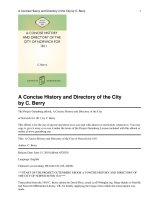THE RISE OF OPEN SOURCE LICENSING ppt
Bạn đang xem bản rút gọn của tài liệu. Xem và tải ngay bản đầy đủ của tài liệu tại đây (3.86 MB, 263 trang )
The Rise of Open Source Licensing
Mikko Välimäki
A Challenge to the Use of Intellectual Property
in the So ware Industry
Mikko Välimäki The Rise of Open Source Licensing
Op — from Linux to Firefox and MySQL database
— has changed so ware business as we knew it. New start-ups have
challenged industry heavyweights from Microso to Oracle with inno-
vative copyright licensing strategies and courageous anti-patent policies.
Almost every major so ware company has been forced to react to the
commodifi cation trend.
Drawing from detailed case studies, historical narrative and the ap-
plication of economic theory, this book shows how open source licensing
is used for strategic advantage. So ware developers enter open source to
distribute their work more effi ciently and increase innovation. So ware is
no longer property, they say. Interestingly, everything has worked despite
— rather than because of — ever-expanding intellectual property rights.
Is there a limit? In the United States, the headline cases by SCO against
Linux supporters and users opened the surface of intellectual property
infringement risks. In Europe, there is ongoing public debate about the
impact of so ware patents on open source. This book goes beyond fear and
doubt arguing that such legal risks are in the end just necessary but man-
ageable uncertainties, which always come with a new business model.
M V teaches technology law at the Helsinki University of
Technology. He has consulted extensively on open source licensing.
ISBN 952-91-8769-6
T P
h p://pub.turre.com/
Cover photo: Ville Oksanen
9 789529 187690
225581_Valimaki_kansi2.indd 1225581_Valimaki_kansi2.indd 1 18.5.2005 16:56:3918.5.2005 16:56:39
PUBLISHED BY TURRE PUBLISHING, A DIVISION OF TURRE LEGAL LTD.
Aleksanterinkatu 17, 6th floor, Helsinki, FI-00100, Finland, />Copyright © 2005 Mikko Välimäki
First Edition. Some Rights Reserved.
This book is licensed under the terms of Creative Commons Attribution-NonCommercial-
NoDerivs 2.0 license available from Accordingly, you are
free to copy, distribute, display, and perform the work under the following conditions: (1) you
must give the original author credit, (2) you may not use this work for commercial purposes,
and (3) you may not alter, transform, or build upon this work.
ISBN: 952-91-8769-6 (printed)
952-91-8779-3 (PDF)
Printed in the Helsinki University Printing House.
Mikko Välimäki
THE RISE OF OPEN SOURCE LICENSING
ACHALLENGE TO THE USE OF INTELLECTUAL PROPERTY IN THE
SOFTWARE INDUSTRY
III
FOREWORD
This book is the result of my PhD studies at the Helsinki University of
Technology. I started working towards a doctoral degree right after
graduation from the University of Helsinki in 1999. I was supposed to
write a thesis in law. Now I need to apologize my then-supervisors profes-
sor Niklas Bruun and docent Pekka Timonen not to complete the thesis at
the law faculty in four years as was once planned. What happened was
that I met my future academic mentor, professor Jukka Kemppinen, who
had just started his professorship at the Helsinki University of Technology.
He convinced me to change my plans and my university in the late 1999.
The actual theme of this thesis started to emerge during my year at UC
Berkeley from 2000 to 2001. At that time I was working with Olli Pitkänen
and we were supposed to study digital rights management. But I went on
and spotted open source. I was lucky to participate at some of the first
business and technology conferences ever that were arranged on the topic
in California. I concluded that this is the area I have the best knowledge of
and, besides, it doesn’t seem to be a fad that disappears in the next two
years. So why not write about it?
The main creative writing periods of this book were in October 2003 in
Berkeley libraries and cafes, and August 2004 in the Starbuckses of Santiago
de Chile. In addition, there were also those numerable nights when I com-
pleted separate articles, which form considerable subparts of this thesis. I fin-
ished the work by completing all the open and missing parts under the su-
pervision of professor Juha Laine.
Dissertation examiners professor Jukka Heikkilä and Dr. Ilkka Rahnasto
made a number of substantial comments to a draft version of this book. I
have taken most of them into account. Professor Thomas Riis from Copenha-
gen Business School kindly accepted the invitation to act as the academic op-
ponent.
My understanding of open source has greatly benefited from discussions
with those who practice software business. As the public interest in open
source has grown, I have found myself lecturing and consulting open source
licensing to different organization from Finnish software companies to Inter-
IV
American Development Bank. Special mention goes to Antti Halonen who
introduced me to MySQL before there was a company for that particular pro-
ject. Mårten Mickos, MySQL’s CEO since 2001, has also been of help by giv-
ing constructive feedback and kindly sharing his connections.
Another bunch of special thanks go to my research colleagues Ville Ok-
sanen and Herkko Hietanen. In addition to several co-authored research pa-
pers, the founding of Electronic Frontier Finland in 2001 has definitely sharp-
ened my argumentation and overall writing skills. Through the association, I
have had the opportunity to participate into the public policy discussion on
copyright and patents from the inside.
I want to also thank Olga ja Kaarle Oskari Laitisen Säätiö, Jenny and Antti
Wihuri Foundation, Helsingin Sanomain 100-vuotissäätiö, Soneran tutki-
mussäätiö, Ella and Georg Ehrnrooth foundation and the Research Founda-
tion of Helsinki University of Technology for their grants supporting my re-
search work when that support was most needed.
Finally, thanks to my family, friends and colleagues not especially men-
tioned. There are just too many people I’ve met at universities, conferences,
business meetings and bars all around the world who have given their sup-
port and contribution in one way or other to this project. It makes me no
sense to list you all.
“Meet the new boss – same as the old boss.”
*
Lauttasaari, Helsinki, 30
th
March 2005
Mikko Välimäki
*
Final verse from The Who song Won’t Get Fooled Again (1971). Lyrics by Pete Townshend.
V
TABLE OF CONTENTS
FOREWORD III
TABLE OF CONTENTS V
ABBREVIATIONS IX
1 INTRODUCTION 1
1.1 P
ROBLEM 1
1.2 T
ERMINOLOGY,PERSPECTIVE AND LIMITATIONS 3
1.3 M
ETHOD 5
1.3.1 Rationale for Different Methods Used 5
1.3.2 Continuing Patterns in Business History 6
1.3.3 An Economic Perspective 7
1.3.4 Comparative Law and Social Norms 8
1.4 A
CADEMIC CONTEXT AND SOURCES 10
1.5 OVERVIEW OF THE STUDY 11
2 FROM PROPRIETARY TO OPEN: EVOLVING LICENSING MODELS IN
SOFTWARE INDUSTRY 13
2.1 S
OFTWARE INDUSTRY 13
2.1.1 A Short Historical Overview 13
2.1.2 Market Size and Regions 15
2.1.3 Emergence of Open Source 16
2.1.4 Open Source and Software Business Models 19
2.2 P
ROPRIETARY LICENSING 21
2.2.1 IBM’s Unbundling Decision and Corporate Licensing 21
2.2.2 Mass Markets Licensing and Shareware 24
2.2.3 Proprietary Licensing Today 26
2.3 F
REE SOFTWARE AND OPEN SOURCE LICENSING 30
2.3.1 BSD License and Unix Copyrights 30
2.3.2 GNU General Public License, Linux and SCO 33
2.3.3 Open Source Enters Vocabulary 36
2.4 S
OCIAL AND POLICY DIMENSIONS OF OPEN SOURCE 40
2.4.1 Open Source and Individual Empowerment 40
2.4.2 Community and Its Camps 42
2.4.3 Ethical or Technical Goals? 44
2.4.4 Influencing Political Institutions 45
2.4.5 Practical Public Policy Initiatives 46
2.5 C
ONCLUSION:EXPLAINING THE INCREASING ROLE OF OPENNESS 48
VI
3 ECONOMIC PRINCIPLES OF SOFTWARE PRODUCTS 50
3.1 E
CONOMIC CHARACTERIZATION OF SOFTWARE PRODUCTS 50
3.1.1 A Network Economics Approach 50
3.1.2 Software as an Economic Good 51
3.1.3 Components and Systems 54
3.1.4 Path Dependence, Lock-In and Network Effects 56
3.2 E
CONOMICS OF SOFTWARE COPYRIGHT 58
3.2.1 Motivation of Developers 58
3.2.2 Investors and Incentives 59
3.2.3 Costs of Copying 61
3.2.4 Optimal Limits of Copyright 62
3.2.5 Compensation Mechanisms 65
3.2.6 Is Software Copyright Inefficient? 67
3.3 E
CONOMICS OF SOFTWARE INNOVATION AND PATENTS 69
3.3.1 Innovation in the Software Industry 69
3.3.2 Difficult Relationship Between Innovation and Patents 71
3.3.3 Patents as Strategic Assets 73
3.3.4 Different Means to Appropriate Innovation 74
3.3.5 An Open Innovation Model 75
3.4 C
OMPETITION POLICY AND THE LIMITS OF EXCLUSIVE RIGHTS 78
3.5 S
UMMARY:ECONOMIC RATIONALE OF OPEN LICENSING 80
4 INTELLECTUAL PROPERTY AND ITS DISCONTENTS 82
4.1 C
HALLENGE OF SOFTWARE PROTECTION 82
4.1.1 Early Discussion and Practice 82
4.1.2 WIPO’s Proposal 85
4.2 C
OPYRIGHT AND ITS LIMITS 86
4.2.1 Software Enters Copyright Law 86
4.2.2 Interoperability Debate 87
4.2.3 Current Extent of Software Copyright 91
4.3 T
HE RETURN OF PATENTS 94
4.3.1 United States Leads 94
4.3.2 Europe Follows 95
4.3.3 International Policy 98
4.3.4 Current Extent of Software Patents 99
4.4 T
ECHNICAL PROTECTION 101
4.4.1 Early Copy Protection Systems 101
4.4.2 Anti-Circumvention Legislation 102
4.4.3 Is Technical Protection Effective? 103
4.4.4 The Promise of Trusted Systems 104
4.5 A
RE INTELLECTUAL PROPERTY LAWS OUT OF BALANCE? 105
4.5.1 Balancing Principle 105
VII
4.5.2 Expansion Trend 106
4.5.3 Open Source as a Balancing Force? 109
4.6 C
ONCLUDING REMARKS:AN OPEN PERSPECTIVE ON INTELLECTUAL PROPERTY 111
5 OPEN SOURCE LICENSES AS ALTERNATIVE GOVERNANCE MECHANISMS
113
5.1 B
ARGAINING IN THE SHADOW OF INTELLECTUAL PROPERTY LAW 113
5.1.1 What Makes a License Open Source? 113
5.1.2 What Is Not Required? 114
5.1.3 Enforcing an Open Source Bargain 116
5.1.4 Licenses Catego rized 117
5.1.5 Popularity of Open Source Licenses 121
5.1.6 A Framework for License Analysis 123
5.2 GNU GPL
AND STRONG RECIPROCITY 124
5.2.1 Derivative Works in Copyright Law 124
5.2.2 Derivative Works and GPL 130
5.2.3 Patents and GPL 139
5.2.4 GPL and License Compatibility 140
5.2.5 Other Licenses with Strong Reciprocity 142
5.3 GNU LGPL
AND STANDARD RECIPROCITY 146
5.3.1 LGPL Functionality 146
5.3.2 Other Licenses with Standard Reciprocity 148
5.4 BSD
AND PERMISSIVE LICENSES 151
5.4.1 BSD Functionality 151
5.4.2 Other Permissive Licenses 152
5.5 E
XCURSION:CREATIVE COMMONS OPEN CONTENT LICENSES 154
5.5.1 Background 154
5.5.2 Creative Commons Functionality 155
5.5.3 Risk Allocation and Warranties 158
5.5.4 Internationalization and Formalities 159
5.5.5 Concluding Remarks 161
5.6 S
UMMARY:COMPETITION BETWEEN EVOLVING LICENSING STANDARDS 161
6 DEFENSE WITH OPEN SOURCE: INFRINGEMENT RISK MANAGEMENT AND
PATENTS 164
6.1 H
OW TO MANAGE IPR INFRINGEMENT RISKS? 164
6.1.1 Background 164
6.1.2 Nature of Third Party IPR Infringements 166
6.1.3 Alternatives to Manage Risks 169
6.1.4 Actual Management Practices 174
6.1.5 Concluding Remarks 178
VIII
6.2 PATENTING PROBLEM AND POSSIBLE POLICY SOLUTIONS 179
6.2.1 Background 179
6.2.2 Open Source Licenses and Infringement Risk 180
6.2.3 Development Process from Patenting Perspective 182
6.2.4 Policy Debate on Open Source and Patents 183
6.2.5 Liability Exceptions for Open Source? 185
6.3 C
ONCLUSION:IPRLAWS CAN BE TUNED 186
7 OFFENSE WITH OPEN SOURCE: CASE STUDIES ON LICENSING 188
7.1 L
ICENSING OPEN SOURCE FOR PROFIT 188
7.1.1 Product Pricing Possibilities 188
7.1.2 Problem of Development Control 189
7.2 C
ASE STUDY 1: FREE LICENSES AND OPERATING SYSTEM SOFTWARE 192
7.2.1 Introduction 192
7.2.2 Market Overview 194
7.2.3 Study Framework 195
7.2.4 Microsoft Windows 196
7.2.5 Apple OS X 200
7.2.6 GNU/Linux Distributions 202
7.2.7 Concluding Remarks 204
7.3 C
ASE STUDY 2: DUAL LICENSING AND EMBEDDED SOFTWARE 206
7.3.1 How Dual Licensing Works? 206
7.3.2 Study Framework 208
7.3.3 Sleepycat Software Inc 209
7.3.4 MySQL AB 211
7.3.5 TrollTech AS 212
7.3.6 When Does Dual Licensing Make Sense? 214
7.4 C
ONCLUDING REMARKS 216
8 CONCLUSIONS 218
8.1 T
HE RISE OF OPEN SOURCE 218
8.2 IMPACT ON LICENSING PRACTICES 219
8.3 I
MPACT ON INTELLECTUAL PROPERTY MANAGEMENT 221
8.4 I
MPACT ON COMMERCIAL REGULATION AND LEGAL STUDY 222
FIGURES AND TABLES 225
REFERENCES 227
A
RTICLES,BOOKS AND REPORTS 227
N
EWS,INTERVIEWS AND ONLINE-SOURCES 237
C
OURT CASES,OFFICIAL DOCUMENTS AND LICENSES 245
INDEX 249
IX
ABBREVIATIONS
BSA Business Software Alliance
BSD Berkeley Software Distribution
CC Creative Commons
CPL Common Public License
CP/M Control Program for Microcomputers
EPO European Patent Office
EU European Union
FLOSS Free/Libre and Open Source Software
FSF Free Software Foundation
GNU GNU’s Not Unix
*
GPL GNU General Public License
IP Intellectual Property
IPR Intellectual Property Rights
IT Information Technology
LGPL GNU Lesser General Public License
MIT Massachusetts Institute of Technology
MPL Mozilla Public License
MS-DOS Microsoft Disk Operating System
OSD Open Source Definition
OSI Open Source Initiative
OSL Open Software License
OSS Open Source Software
PC Personal Computer
TC Trusted Computing
US United States
USPTO United States Patents and Trademark Office
W3C World Wide Web Consortium
WIPO World Intellectual Property Organisation
WTO World Trade Organisation
*
GNU is a recursive acronym.
INTRODUCTION • 1
1INTRODUCTION
1.1 Problem
MOUNTAIN VIEW, Calif. (February 23, 1998) - Netscape Communica-
tions Corporation (NASDAQ:NSCP) today announced the creation of
mozilla.org, a dedicated team within Netscape with an associated Web site
that will promote, foster and guide open dialog and development of Net-
scape's client source c ode. “Netscape is the first major company to exploit
the power of the open source strategy,” said Eric S. Raymond, open-source
developer and advocate. “Making their client software source code free to
developers is a bold move that will do great things for their products.”
1
Craig Mundie, Microsoft CTO, May 16, 2001: “When comparing the
Commercial Software Model to the Open Source Software model, look care-
fully at the business model and licensing structures that form their founda-
tions. This comparison leads to the conclusion that the commercial software
model alone has the capacity for sustaining real economic growth. Intellec-
tual capital has always been, and will remain, the core asset of the software
industry, and almost every other industr y. Preserving that capital—and
investing in its constant renewal—benefits everyone.”
2
This book is a study on how open source has challenged the thinking
and actual use of intellectual property in the software industry. The emer-
genceofopensourcesoftwareandtherapidexpansionoftheInternet
have brought new software licensing practices to mass markets. For a
short time at least, new entrants have challenged incumbents in the ex-
panding software markets with the help of innovative copyright licensing
strategies and courageous anti-patent policies.
1
Excerpt from Netscape’s press release mentioning term “open source” for the first time. See
Netscape (1998).
2
This was the message when Microsoft tried to push their share source initiative to compete
with open source. See Mundie (2001).
INTRODUCTION • 2
GNU/Linux operating system, Apache web server and MySQL data-
base are perhaps the best-known examples of open source software. On
their part, the biggest companies in the industry from IBM to Apple have
adapted to the changing environment with different open source licensing
and operation strategies. But not everyone is winning; Netscape lost its
market share despite the “bold move” to open source strategy announced
in 1998. Also many other initiatives have had hard times to convince that
going open source can indeed be a viable business decision.
This draws us to the main questions of this study:
- Has open source changed licensing practices in the software industry
from a historical perspective? (chapter 2)
- Do the economic theories on software, copyright, and innovation
work with the principles of open source? (chapter 3)
- Does open source challenge the development of software copyright,
patents and other intellectual property laws? (chapter 4)
- What are the most relevant open source licenses and how are they
built on intellectual property law and economic theory? (chapter 5)
- How actual are patent and other intellectual property infringement
risks in the use of open source and how the potential risks can be de-
fensively managed at the social policy and individual firm level?
(chapter 6)
- Are there interesting industry cases where open source licensing
models have been used as competitive tools? (chapter 7)
The overall argument of the book is that open source licensing has indeed
changed the ways the software industry thinks of and actually uses intellectual
property. Almost all major software companies in the world have since
1998 started to adopt open source licensing models as part of their busi-
ness. Open source code and free copying and distribution models have
made inroads to the intellectual property licensing practices of industry
heavyweights. It may well be that in some application areas – such as the
basic Internet infrastructure software – there are no long-lasting mass
markets in the future for closed source code software products with re-
INTRODUCTION • 3
stricting licensing terms. However, it is very difficult to assess how fun-
damental and deep the change has actually been. In many sectors of the
software industry – such as custom software development and specific in-
dustry applications – open source is still a non-issue.
This book further argues that the implications of open source to the
management of intellectual property are twofold. First, intellectual prop-
erty infringement risks must be taken more seriously when open source
softwareisused.Thisisbecauseopen source increases the negative effects from
the continuous expansion of intellectual property rights. Second, “Internet-
businesses” are finally breaking through into software markets. This
means that the value of intellectual property increases from sharing but also be-
comes more complex to appropriate.
Finally, this book argues that open source can have relevant implica-
tions on intellectual property rights policy. First, openness balances com-
mercial regulation. Open licensing systems have proved how potential
drawbacks from overregulation can be fixed without state intervention. In
this way, open source also emphasizes a more ma terial study of intellectua l
property rights. When a substantial number of right holders in a given in-
dustry decide not to enforce their core intellectual property rights – relying
on economic-rational arguments – the premises of the policy discussion
can be seen in a new light. Why and how do companies do that? What
does it mean to the intellectual property system as a whole? Whether one
should hold to the government granted intellectual property rights to the
fullest is again a relevant question for any software developer and public
policy maker alike.
1.2 Terminology, Perspective and Limitations
The main objective throughout this book is intellectual property rights
(IPRs). They can be defined as government-granted limited – both in term
and scope – monopolies (or privileges) to govern certain uses of software.
This limited-monopoly definition assumes implicitly that the rights can’t
be omnipotent but must be balanced somehow. For practical matters, the
discussion is limited to copyright (governing “works”) and patents (gov-
erning “innovations”). In more formal legal literature, terms “the copy-
INTRODUCTION • 4
right protection of computer programs” and “computer implemented in-
novations” are commonly used. This books uses however more general
terms software copyright and software patents when we speak of copyright
and patents as applied to computer programs. Such terminology is also
more common in economics and other social sciences literature.
Software licenses are contractual documents, which define how copyright
and patent rights are used. A licensor is typically a software developer
(software company) who licenses more or less of these rights to licensees.A
licensee can be either another developer or end-user. Term open source is
defined as a set of software licenses, which follow certain criteria further
defined in Open Source Definition. Thus, this book studies how software
companies apply intellectual property laws with open source licenses. –
With proprietary software and licenses, this book refers generally to every-
thing else but open source. This should not be seen as a clear-cut categori-
zation, however. There are many proprietary licenses, which fulfill some
of the criteria of open source (e.g. the sharing of source code, no copyright
or patent royalties) but not all.
Software industry refers in this book to companies, which offer business
software products for server and desktop computers. Specifically, it refers to
those parts of the industry where open source licenses are being used ex-
tensively. It is obviously not possible to assess licensing practices and im-
plication within the industry as a whole. Thus, for example, specific issues
with computer games and embedded systems are largely omitted.
There are two leading perspectives in this book:
- Firstisthatofasoftware develope r – typically a software company.
Since licensing is essentially one of the operative functions of any
software company, it is natural to discuss how open source impacts
licensing practices. Further, the developer perspective often fits well
with the views of small or medium sized companies, or other inde-
pendent ventures, whose entire business somehow depends on the
licensing decisions.
- Second is that of a public policy maker. The general implications from
changing licensing practices are inherently public policy questions.
INTRODUCTION • 5
This study identifies implications to the regulation of copyright and
patents as well as intellectual property management within software
companies.
In short, this book sees intellectual property rights “in action”. The se-
lected perspectives necessarily limit the focus to some extent. For example
the descriptive discussions on the historical evolution and (static) legal
concepts of software copyright are in the end only supportive to the main
theses of the book.
1.3 Method
1.3.1 Rationale for Different Methods Used
Chapters 2-4 build a theory of software licensing from historical, eco-
nomic and legal perspectives. In the second chapter, the discussion draws
from business history explaining the role of open software licenses in the
software industry. In the third chapter, the economic theories on networks,
copyright, patents and innovation are described and the role of open
source licensing models within the theory discussed. In the fourth chapter,
the method is mainly legal history describing how the legal protection of
software has been developed and interpreted up to present day.
Rationale for this three-tier approach (history, economics and law) is an
assumption that to fully understanding the impact of open source licens-
ing one needs to be aware of a number of factors that software developers
consider for licensing decisions. In addition to purely economic argu-
ments, there are significant legal ramifications that determine available li-
censing options. And above all this, there are ideological, philosophical,
historical, technical and social facts that may be decisive in some contexts.
Simply put, a one-eyed view to the phenomena of open source software
licensing would be filled with half-truths and errors.
Still, one needs to ask: why do we discuss different approaches in one
study. Why don’t simply delineate the problem under study so that for ex-
ample only the legal nature and legal analytics of the licenses would be
studied? Again here, it is assumed that such a separate study would have
INTRODUCTION • 6
less practical and historical importance than the one that would mix the
knowledge from different fields of study.
1.3.2 Continuing Patterns in Business History
A few remarks on the method of the historical analysis practiced in this
book. In historical research, this book stresses the role of continuing social
patterns and processes over unique events. For example, the breakthrough
of open source in the late 1990s had its roots in the communities of early
computer hobbyists of 1960s. With necessary environmental changes, such
as the growth of the Internet as a communication platform and shift in en-
terprise computing from mainframes to cheap microcomputers, open
source code and the ideas of sharing and communities returned and took
over.
There are substantial similarities in our analysis to the triumph of open
source to Chandler’s approach to the business history of electronics and
computer industries of the 1900s as well as Christensen’s approach to the
patterns of technological innovation.
3
First-movers and new innovators
have been repeatedly able to gain (temporary) market power in the soft-
ware industry until the proponents of new technological breakthroughs
and ideas have taken control. In this sense, open source can be seen as a
revolutionary new way of doing and distributing software in the new en-
vironment.
However, open source is not only a technological paradigm. It is even
more about the fundamental ways of how software is being socially devel-
oped and legally licensed. In these senses, the change open source has
brought to software industry seems, at least for now, more fundamental.
Technology arguably changes much quicker than social and legal norms.
Therefore, more emphasis is given to the social and policy dimensions
than in the more traditional studies of the industry history.
4
For instance
issues such as the emergence of development community norms and the
3
See Chandler (2001) and Christensen (1997).
4
Lazonick (2003) points out the need to study how social and other institutional factors initiate
economic transformation in a given industry. His theory is based broadly on North’s (1981)
somewhat more abstract theory on institutional change and its effect on innovation and entre-
preneurship.
INTRODUCTION • 7
formation of a legal policy towards interoperability and software patents
are covered in this book with more detail.
Finally, in describing historical patterns one must be selective. It is obvi-
ously not possible to give a perfectly detailed account of all the events,
which combined lead to particular outcomes. There are many alternative
and convincing ways to tell the history of open source within the context
of software industry. The author has used here a kind of bottom-up ap-
proach: for instance the history of software licensing is seen from the per-
spective of individual developers and license authors. In the end, open
source licensing can be accounted to the ideas of individual programmers
and their previous licensing practices. Thus, the history of for example
shareware licensing in the 1980s needs more account than corporate soft-
ware licensing practices from that time.
1.3.3 An Economic Perspective
Economic analysis in this book can be best described to follow the so-
called pin-factory approach. In short, the aim is to understand how the
business and economics of open source licensing function in practice
through interviews and hands-on observations both in the real life and In-
ternet discussions archives. Then, the result is explained in the terms of
economics.
5
Economic concepts used in the academic discussion on networks, copy-
right, patents and innovations are introduced and their applicability in
open source development discussed. An obvious challenge in this kind of
a descriptive approach is that many of these concepts are used in norma-
tive policy discussion such as the regulation software patents. The fact is
that many academics may have normative goals hidden in their argumen-
tation. That is the main reason why the discussion on economic concepts is
kept rather abstract.
Although this book discusses the economics of copyright and patents
among others, it should be clarified that the aim is not to follow a tradi-
tional law and economics approach. We accept that laws are always more
5
See Borenstein et al (1998).
INTRODUCTION • 8
or less inefficient. Further, it is useful to strive towards more social effi-
ciency through legal development only when the law is seriously out of
balance and when it can be enforced with relatively moderate costs. In
many cases there are alternative governance mechanisms to complement
the development of formal legal institutions.
6
Thus, the main idea in this book is to study how open source licensing
privately balances “normal” inefficiencies in intellectual property regula-
tion and how licensing arrangements have perhaps caused different sorts
of inefficiencies in the software markets.
7
Also, we are interested in the
strategic and practical possibilities software developers have for reacting
to the economic implications of the existing laws. In this analysis, the game
theoretical models built in the economics literature of business strategy –
including the economics of networks and innovation – typically help out
in pointing out the relevant environmental features that affect individual
decision making.
8
1.3.4 Comparative Law and Social Norms
Although most open source licenses have been written according to the
United States law, each one should be legally interpreted in the jurisdic-
tion the license is actually used. However, it must be stressed that the ac-
tual use of the licenses is flexible and extraterritorial – independent of pos-
sibly differing national legal interpretations. Distributed development and
free redistribution on the Internet do not stop at national borders or na-
tional laws. Therefore, this book has an international and comparative ap-
proach to legal analysis.
9
6
See e.g. Dixit (2004), pp. 1-14, presenting an overview of the approach he calls “lawlessness
and economics” or “economics in the shadow of the law”.
7
See also Epstein (1997), pp.1173-1174, who notes pessimistically that the economic analysis of
legal doctrines has been so thorough that there are significant risks of just repeating of what is
already known. Also advancing the research with more rigorous economic analysis has im-
plied that the results are harder to understand and thus less useful. Interestingly, Epstein goes
on to suggest that economic studies of law should focus to the evolution of particular institu-
tions and social arrangements “such as the evolution of telecommunications, public utilities…
and nonprofit organizations”.
8
Shapiro (1989).
9
For practical reasons, we limit the study mainly to the US and EU laws.
INTRODUCTION • 9
Following Mattei, we see the sources of law in a competitive setting.
10
There is no specific law on the rights to software and litigation on open
source licensing issues has been rare. Thus, the interpretation of licenses
should start from the principles of copyright and other intellectual prop-
erty laws and already developed case law on software licensing.
In addition, also the so-called community norms must be taken into ac-
count as a competitive normative source. They are manifested for example
in the ethical guidelines of the development community and lists of fre-
quently asked questions by license authors and community spokesper-
sons.
11
From a narrow legal perspective, the community norms can be seen
as secondary norms reflecting the objectives of the licenses. In practice, the
factual community norms may affect the behavior of software developers
and users even more than formal laws and contracts. Potential reasons are
that the applicable legal rules on intellectual property rights and licensing
are unclear, developer communities form rather close-knit social networks
that voluntarily avoid legal disputes, and that the costs of law enforcement
on the Internet are high.
12
Linus Torvalds has said on the risk that Linux’s GNU General
Public License (GPL) would not be honored: ”My fears are mitigated
by reality. Somebody might do it for awhile, but it is the people who
actually honor the copyright, who feed back their changes to the
kernel and have it improved By contrast, people who don’t honor
theGPLwillnotbeabletotakeadvantageoftheupgrades,andtheir
customers will leave them. I hope.”
13
As noted, actual legal conflicts and continuing license violations have
been considerably rare taking into account the popularity of open source.
This has been credited mainly to proactive community self-control and ef-
10
Mattei (1997), pp. 104-105, makes a clear difference between legislation and legal rules. He
argues that legal rules are composed of any “legal proposition that affects the solution of a le-
gal problem” independent of its origin. Attempts to strictly classify and limit the sources of law
may lead to unrealistic views of the legal rules.
11
See e.g. Debian Free Software Guidelines and Himanen (2001).
12
See Ellickson (1991), pp. 282-283. It must be noted that Ellickson studied the social norms of a
cattle rancher community so his results can be used only analogically.
13
Torvalds and Diamond (2001), pp. 96-97.
INTRODUCTION • 10
fective mutual conflict resolution for example by stopping the distribution
of violating source code, rewriting violating parts or buying a proprietary
license.
14
On these grounds, legal research in this book does not stop at
conservative risk analysis in chapter six but continues to investigate the
possibilities and business effects of the new innovative licensing tech-
niques in chapter seven.
1.4 Academic Context and Sources
There has already been published many books on open source from
technical, business and social science perspectives.
15
Hundreds of aca-
demic papers from different angles are readily available.
16
There are also at
least three books specifically on open source licensing.
17
Most of the book-
length material published on licensing so far is however rather practical
and sharply restricted to legal analysis. To contrast, the aim of this study is
to offer a comprehensive and academic, yet historically balanced and prac-
tically useful insight into the whole range of the open source licensing
phenomena.
While the aim can be criticized as broad, the book does have a focus. The
main academic tradition where this book can be connected to is the law and
economics of intellectual property rights. Historical and legal analyses ulti-
mately support the task of explaining how the growing popularity of open
source licensing affects (if it does) the industry practices of intellectual
property rights management.
Specifically, this book aims to contribute:
14
See e.g. Shmitz and Castiaux (2000), pp. 33-34 and Moglen (2001b).
15
For a technical book see e.g. Ferrel and Fizgerald (2002), business book see e.g. Fink (2003),
and social science book see e.g. Weber (2004).
16
For example “Open Source Research Community” hosted at opensource.mit.edu posted 56
research papers (mainly economics and other social sciences) on their website during 2004.
Westlaw gives for the database “Journals & Law Reviews Combined” a total of 53 articles men-
tioning “open source” in their title; 25 of those were published in 2004. – As an anecdote,
scholar.google.com (including all sort of journal articles, conference proceedings, draft online
papers etc.) gives a total of about 2400 hits for articles, which have “open source” in their title,
in March 2005.
17
Rosen (2004) and St. Laurent (2004) can be described as practical “hint-books” written by
lawyers to developers while Metzger and Jaeger (2002) is a detailed legal analysis of open
source licensing in the context of German law.
INTRODUCTION • 11
- A business history perspective on the emergence of open source li-
censing as a pattern combining previous software licensing and de-
velopment practices
- More in-depth analysis of the key intellectual property issues in
open source licenses and their impact to software business
- New real world case studies on intellectual property risk manage-
ment and licensing practices in open source development
Main sources of the study are academic literature in the software indus-
try history, economics of software and intellectual property law on soft-
ware. In addition, relevant trade journals, magazines and online sources
are used to provide details for actual industry practices and commentary
on historical events. In the empirical parts of chapters six and seven the
data has been collected from interviews, questionnaires and available
market data and statistics.
Many studies on software industry start by stating that there is not
much previous research since the industry is still relatively young.
18
While
there is much true in this statement, it also undermines the amount of re-
search efforts done. Today it is not difficult to find recent research on
software industry starting from the industry history. The same can be said
about economics; the central concepts used in this study such as the eco-
nomics of networks, copyright, patents and technological innovation have
been under major study already from the 1960s. Also the legal issues re-
garding software protection aren’t new; the roots of modern software
copyright and patents discussion are also in the 1960s. And as noted, dur-
ing the last few years, the academic literature of open source has taken off.
1.5 Overview of the Study
The second chapter of the book describes the growth, size and segmen-
tation of the international software industry. We are especially interested
in how software has been sold and how open source and free software li-
18
See e.g. Torrisi (1998) and von Westrap (2003).
INTRODUCTION • 12
censing has emerged to challenge established industry practices. We also
discuss the issues of licensing in the industry policy development.
The third chapter discusses the economic theories of networks, copy-
right, patents and innovation in the context of software products. All theo-
ries characterize different aspects of software products bearing some dif-
ferences but also many similarities. Aim of this chapter is to build a coher-
ent theory where open source software licensing models can be analyzed
within a larger economic context.
The fourth chapter discusses the evolution of legal and technical protec-
tion of software. Some commentators have criticized that the continuous
expansion of different overlapping intellectual property laws over soft-
ware has implied that the law is now substantially out of balance. We end
the chapter by reviewing the evidence and discussing the possibilities of
private balancing of intellectual property laws through open source.
The fifth chapter discusses how different open source licenses have
evolved in practice. Licenses are categorized and their functionality further
analyzed. Open interpretation issues as well as implications to software
business are identified. Finally, the chapter ends with a discussion on open
content, on how the techniques of open source licenses have been adopted
for use in other works of art than computer software.
Any use of open source in business environment includes legal risks. In
this chapter we discuss how software patents and other intellectual prop-
erty infringement risks can be managed at individual firm and social pol-
icy level. We start from the more general intellectual property rights in-
fringement risk management alternatives in open source development.
From there, the discussion is extended to the social problem of software
patents especially in the European policy context.
Finally, the seventh chapter studies how open source licenses have been
used offensively as a part of market-changing business strategy. First case
study is about operating system software markets and how open source
alternatives have changed the existing market structure during the recent
years. The second one describes a specific open source licensing model
called dual licensing and discusses how several start-up companies have
benefited from using it.
FROM PROPRIETARY TO OPEN • 13
2FROM PROPRIETARY TO OPEN:EVOLVING LICENSING
MODELS IN SOFTWARE INDUSTRY
This chapter describes the growth, size and segmentation of the interna-
tional software industry. We are especially interested in how software has
been sold and how open source and free software licensing has emerged to
challenge established industry practices. We also discuss the issues of li-
censing in the industry policy development.
2.1 Software Industry
2.1.1 A Short Historical Overview
Software industry is an ambiguous concept. The industry is both young
and characterized by rapid technological development. The industry has
been shaped by numerous expansion times and technological paradigm
shifts during its less than fifty year history. Thousands of companies have
grown and disappeared. Today, only few companies that operated in the
1950s and 1960s have survived and most of the contemporary industry
leaders were founded less than thirty years ago.
Campbell-Kelly offers a useful taxonomy of software industry from his-
torical perspective. He identifies three major categories of software com-
panies based on their operating model: software contractors, corporate
software producers and mass-market software producers.
Category Software contractors
(1950s -)
Corporate software
producers (1960s -)
Mass-market software
producers (1970s -)
Companies SDC (1956) SAP (1972) Microsoft (1975)
CUC (1955) CA (1976) MicroPro (1978)
CSC (1959) Oracle (1977) Lotus (1982)
Business Projects Product tailoring, services License sales
Table 1. A historical taxonomy of the software industry
19
19
Campbell-Kelly (2003), p. 9
FROM PROPRIETARY TO OPEN • 14
In the first wave came software contractors. They established the soft-
ware industry in the 1950s selling large-scale software projects to the
United States government and largest corporations. In the 1960s the indus-
try slowly shifted towards software products and expanded to Europe and
other continents. After IBM, the industry’s “natural” monopolist, unbun-
dled software from hardware in 1969, the software product markets took
off. Many new software products companies were founded and the indus-
try expanded to serve a greater scale of users. Software services, training
and support were major income sources to software producers at that
time. What contractors and product companies had in common was that
they both served mainly the corporate market, which was based on main-
frame hardware.
20
Personal computer revolution was the next turning point in the indus-
try. A new form of software business was mass-market software based
from the beginning on copyright license sales and minimal after-sale serv-
ices. This new part of the industry was in many ways disconnected form
the corporate software markets. Mass-market software markets expanded
rapidly in the “gold rush” of the late 1970s and early 1980s.
21
In 1981 IBM
introduced its PC, which was based on open architecture meaning that
third party manufacturers were able to produce both software and hard-
ware.
22
PC became soon the dominant technology and helped the most
successful of the new entrants to grow to the heights of the corporate soft-
ware companies.
The focus of this study is on software producers. Since the late 1990s the
boundaries between the corporate and mass-market software producers
have started to some degree melt. Both the growth of Internet and the
emergenceofopensourceproductshavecatalyzedaprocessofbuilding
the bridge between corporate and end-user markets. For example Micro-
soft, which has been a typical example of a mass-market software products
company, and Oracle, an archetype of a corporate software company,
20
Campbell-Kelly (2003), pp. 118-119, 161-162.
21
Campbell-Kelly (2003), p. 203.
22
According to Grindley (1995), p. 141, major reasons for open architecture were rush to mar-
kets, low-risk because of reliance in third party suppliers, and technical difficulties to protect
the complex standard. IBM did try to make BIOS chip design proprietary but third party
manufacturers soon circumvented it.
